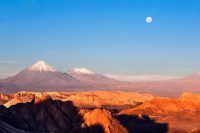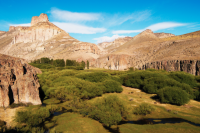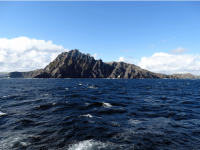Nearby destinations to visit (relatively speaking)
Most national parks exist to protect forests, flora, and fauna. Jaramillo National Park is different. It exists to protect a fossilized – or petrified – forest, one that existed 175–170 million years ago. But now it is a desert – and a true Jurassic Park.
The Petrified Forest is famous worldwide for its paleontological value. Once lush, humid, and brimming with life, the site is now located in the middle of a flat, dry desert – the Patagonian Steppe.
This park is one of the most important fossil findings in Argentina. And it is one of the most significant and famous petrified forests in the world because of the high quality of its fossils and its immensity.
Jaramillo National Park has some of the oldest petrified wood in the world and some of the most remarkable fossil specimens. There are more than 200 petrified trees, including the largest in the world, which reaches 3 meters in diameter and 55 meters in length, as well as animal fossils and Paleolithic artifacts.
The Petrification process
The tree rings of the petrified wood tell us that when the petrification process began the forest was already 1000 years old. At that point, there was a sudden massive volcanic eruption that covered the forest in ash. It didn’t incinerate the trees, but preserved their shape and accelerated the petrification process.
Buried with no exposure to oxygen or light, the trees were in the ideal conditions for petrification. Over time, with water washing over it periodically, the wood was gradually replaced with minerals and the forest was preserved with an extraordinary amount of detail. Later, the movement of tectonic plates gradually pushed the buried petrified wood and fossils to the surface.
At the time of the volcanic eruption, these conifer trees were bearing cones at the point of maturity, and so these were magnificently preserved with their seeds intact. This is very exciting for geologists.
The petrified trees have been preserved in both standing positions and tipped over. Curiously, the tipped over ones all face the same direction due to the path of strong winds from the mountains.
The remains of animal fossils millions of years old have also been found here – small rodents, frogs, prehistoric toads, even marine life.
What to see nearby
Cerro Madre e hija, (Mother and Daughter mountain) was once a volcano. Now, its columns of lava are perfectly preserved. The peaks are eroded, but the lava conduit is maintained with a section with perfect hexagons.
Practical tips for visiting
- The park is located in the Patagonian Steppe, so it is arid, cold and windy. It is free to visit and open all year, but spring and summer are the best times to go, so from October to November, though it can be windy all year.
- You won’t come across throngs of tourists at any time. It’s a fascinating place to enjoy in virtual solitude.
- There are audio guides available in the province of Santa Cruz that explain the different parts of the park as you pass through them, which is very helpful.
Planning your trip
Because the Petrified Forest exists in stark isolation, you should plan your trip carefully.
- Go during the day.
- Take a map for safety, food, water and fuel.
- The nearest gas station is 140 kms away in Fitz Roy.
- The nearest town heading north, Puerto Deseado, is 290 kms away and heading south, Puerto San Julián is a mere 230 kms away.
Getting there
From Ruta 3, take Provincial 49 and drive the 50 km unpaved road. There you reach the museum which explains the petrification process.
Nearby destinations to visit (relatively speaking)
- Combine with a trip to Puerto Deseado located on the Atlantic coast, featuring natural reserves and Penguin Island, one of the many places in Argentina and Chile for penguin watching.
- Puerto San Julián, from where you can take a boat trip to watch beautiful black and white skunk dolphins and seabird colonies) and visit the amazing cave paintings in Estancia La María.
No comments yet
There are no comments on this post yet.




Leave a comment